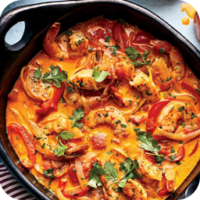Feijoada is one of the most iconic and traditional dishes in Brazilian cuisine. It is a hearty stew made primarily from black beans, pork, and beef, and is often considered the national dish of Brazil. The dish has roots in Brazil’s colonial history, with African and Portuguese influences blending to create this rich and flavorful meal. Feijoada is typically served with rice, farofa (toasted cassava flour), and cabbage, and is traditionally eaten during special gatherings or celebrations.
Key Features of Feijoada:
- Main Ingredients:
- Black Beans: The base of feijoada, providing the stew with its deep, rich flavor and color.
- Pork: Various cuts of pork are used, such as pork shoulder, chorizo, sausage, pork ribs, and salted pork.
- Beef: Dried or salted beef, like beef jerky or beef ribs, is often added for additional flavor.
- Garlic and Onions: Essential aromatics that contribute to the dish’s depth of flavor.
- Spices and Herbs: Ingredients like bay leaves, cumin, coriander, and oregano enhance the flavor profile.
- Orange: A slice of orange is often added, and it’s common to serve feijoada with a wedge of fresh orange for a burst of freshness.
- Preparation:
- The beans are slow-cooked with various cuts of pork and beef, allowing the flavors to meld together.
- The dish is traditionally cooked in a large pot for several hours, often on low heat, until the beans and meats are tender and infused with flavor.
- The meats are usually cut into small pieces or chunks and simmered in the beans.
- Serving:
- Feijoada is typically served with white rice, farofa, cabbage (sautéed or boiled), and sometimes slices of orange for a refreshing contrast to the rich stew.
- It is often accompanied by hot sauce or vinegar to balance the richness.
Cultural Significance:
- Afro-Brazilian Influence: Feijoada has roots in African culinary traditions, as enslaved Africans in Brazil would often use less expensive cuts of meat, such as salted pork, mixed with beans to create a hearty meal.
- Portuguese Influence: The Portuguese brought the practice of stewing beans and meat, which blended with African ingredients and flavors.
- Festive Dish: Feijoada is traditionally enjoyed on Saturdays in Brazil, often served at family gatherings or celebrations. It is considered a communal dish that brings people together.
- National Dish: Feijoada is seen as a symbol of Brazilian culinary culture and identity, often served during festivals, holidays, or even Carnival.
Variations:
- Regional Differences: In some regions of Brazil, the dish may vary slightly. For example, in Rio de Janeiro, feijoada is often served with rice, farofa, and sautéed kale, while in Bahia, it may include dendê oil and a different set of spices.
- Vegetarian Feijoada: There are also vegetarian versions of feijoada, which substitute the meats with plant-based proteins like tofu or tempeh and use vegetable broth instead of meat broth.
Nutritional Value:
Feijoada is a rich and filling dish that provides a good amount of protein from the meats and beans. The beans are also a good source of fiber, while the pork and beef provide essential fats and vitamins. However, due to the fatty meats used in traditional feijoada, it can be a high-calorie dish, so it is typically enjoyed as a hearty, special meal.
Fun Fact:
- The tradition of feijoada as a communal dish is so ingrained in Brazilian culture that it has been said that feijoada is best enjoyed when shared among friends and family, with everyone sitting around the table together.
- Feijoada Completa: This term refers to the full, traditional meal, which includes not only the stew but also all of the accompaniments such as rice, farofa, collard greens, and orange slices.
Summary:
Feijoada is a rich, flavorful Brazilian stew made with black beans, pork, and beef, slow-cooked to perfection. A dish with deep historical roots, it is a beloved part of Brazilian culture and is typically served with rice, farofa, cabbage, and orange. Feijoada is a symbol of Brazilian culinary tradition, enjoyed in large gatherings and during special occasions.














